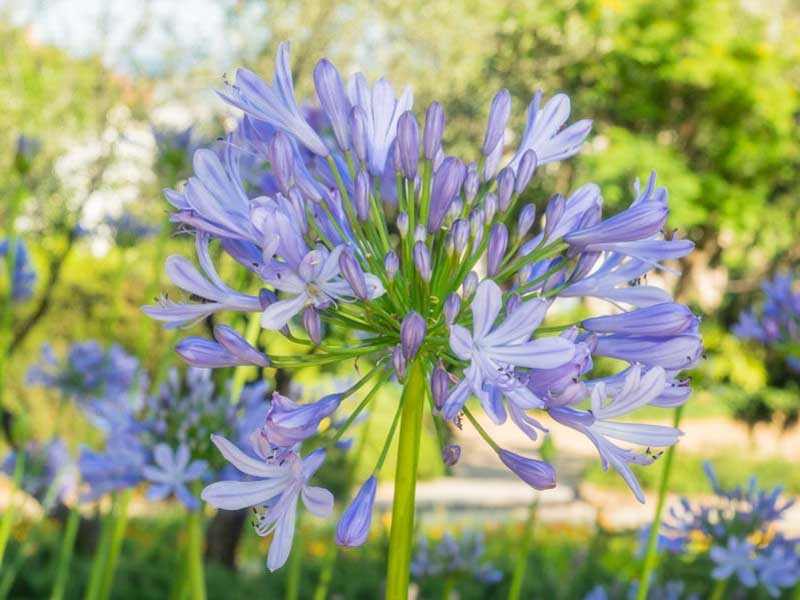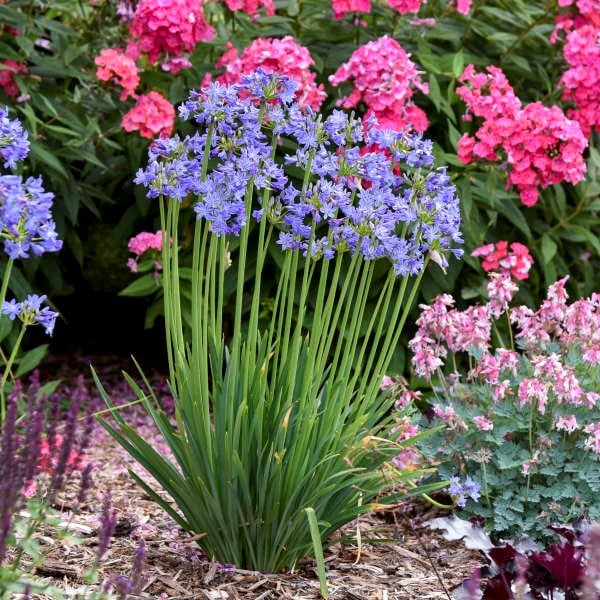Agapanthus Companion Plant Kingdoms: Perfect Pairings for Your Yard
Agapanthus Companion Plant Kingdoms: Perfect Pairings for Your Yard
Blog Article
Letting Loose the Secret to Effective Agapanthus Growing: Tips and Tricks for a Flourishing Garden
In the world of horticulture, cultivating agapanthus successfully calls for a calculated strategy that incorporates different elements of plant treatment. By comprehending the subtleties of agapanthus farming, one can create an atmosphere where these plants prosper and bloom abundantly.
Growing Agapanthus: Finest Practices
When growing Agapanthus, proper dirt prep work is vital for making certain successful development and development of these attractive flowers. Agapanthus, frequently recognized as Lily of the Nile or African lily, thrives in well-draining soil with a slightly acidic to neutral pH level - Agapanthus. Before planting, it is essential to change heavy clay dirts with raw material such as garden compost or peat moss to enhance water drainage and offer necessary nutrients for the plants
To grow Agapanthus, pick an area that obtains complete sunlight to partial color, as this will certainly advertise healthy and balanced development and plentiful flowering. Dig a hole two times the diameter of the plant's root ball and place the Agapanthus at the same depth it was previously expanding. Gently backfill the opening with dirt, weighing down strongly to remove any kind of air pockets around the origins.
Water the freshly planted Agapanthus completely and remain to keep the soil equally moist, particularly throughout the plant's energetic expanding period. Agapanthus. Using a balanced fertilizer once a month can additionally sustain the plant's growth and flowering. By complying with these finest techniques for planting Agapanthus, you can create a sensational display screen of these exciting flowers in your garden
Perfect Dirt Issues for Agapanthus
For optimum growth and blooming success of Agapanthus plants, making sure the soil problems are perfect is crucial. Agapanthus chooses soil that is abundant in nutrients, so including a well balanced fertilizer throughout the growing period can promote healthy and balanced growth and lively blooms.

Watering and Feeding Tips
To make sure healthy and balanced development and vibrant blooms, proper watering and fertilizing techniques are vital for successful Agapanthus farming. Agapanthus plants gain from normal watering, specifically throughout the growing season. It is advised to water deeply when a week, ensuring the soil is damp however not soaked. Throughout warm climate or in pots, even more frequent watering may be required to avoid the soil from drying out totally.
When it concerns fertilizing Agapanthus, a well balanced fertilizer with equal components nitrogen, phosphorus, and potassium can be applied in the spring to advertise healthy and balanced development and flowering. Slow-release fertilizers are ideal for giving nutrients slowly over a prolonged period. Avoid over-fertilizing, as this can bring about too much foliage growth at the cost of navigate to these guys blooms.
Additionally, including raw material like garden compost into the dirt can boost nutrient degrees and improve dirt structure, aiding in the total wellness of the Agapanthus plants. By complying with these watering and feeding pointers, gardeners can guarantee their Agapanthus plants prosper and create spectacular displays of flowers.
Pruning and Deadheading Methods
Proper trimming and deadheading strategies play an important duty in maintaining the wellness and looks of Agapanthus plants, matching the crucial methods of watering and feeding for successful farming. Pruning Agapanthus entails removing invested flower heads, dead or yellowing leaves, and total shaping of the plant to advertise better development. Deadheading, the procedure of eliminating faded flowers, not just improves the plant's appearance yet also motivates more flowering.
When deadheading Agapanthus, it is suggested to clip off the blossom stem at the base making use of sharp, clean shears. This procedure reroutes the plant's power from seed manufacturing back right into origin and vegetation development, promoting a healthier and more durable plant. Regular deadheading can expand the blooming period of Agapanthus and avoid self-seeding, which can lead to overcrowding.
In regards to trimming, Agapanthus normally gain from a light trim after blooming to clean up the plant and motivate fresh growth. Cutting down the spent flower stems and removing any kind of broken or dead vegetation assists preserve the plant's vigor and total appearance. However, it is vital to stay clear of reducing into the crown of the plant, as this can compromise its health and wellness.

Protecting Agapanthus From Pests and Diseases
Applying reliable parasite and condition management techniques is important to securing the health and wellness and vitality of Agapanthus plants in cultivation. Agapanthus are usually durable plants, but they can still succumb numerous bugs and illness if not appropriately cared for. One redirected here typical pest that influences Agapanthus is the Agapanthus borer, a caterpillar that tunnels into the plant, creating damages to the fallen leaves and flowers. To prevent invasions, regular inspection of the plants is crucial. If borers are identified, they can be by hand eliminated, or insecticidal soap can be made use of as a control procedure.
In addition to pests, Agapanthus are prone to illness such as origin rot and fungal fallen leave places. These problems can frequently be protected against by guaranteeing appropriate drainage and preventing overwatering. If indicators of condition show up, influenced parts of the plant must be promptly gotten rid of to prevent more spread. Fungicides might also be utilized as a treatment procedure, following the supplier's try here instructions meticulously. By staying cautious and addressing parasite and illness problems promptly, garden enthusiasts can aid their Agapanthus flourish and grow.

Verdict
In conclusion, effective farming of agapanthus requires proper growing strategies, ideal dirt conditions, adequate watering and feeding, regular trimming and deadheading, and security from parasites and diseases. By adhering to these tricks and pointers, garden enthusiasts can make certain a prospering garden filled with stunning agapanthus blossoms. Agapanthus. Keep in mind to keep constant care and attention to information to advertise the health and durability of these magnificent plants
When growing Agapanthus, correct soil preparation is important for making certain successful development and development of these beautiful blossoms.Water the recently planted Agapanthus thoroughly and proceed to keep the soil equally wet, specifically throughout the plant's active expanding period.For ideal development and blooming success of Agapanthus plants, guaranteeing the dirt conditions are ideal is important. When growing or transplanting Agapanthus, guarantee the dirt is well-prepared to supply the required structure for the plants to develop themselves successfully. One typical pest that affects Agapanthus is the Agapanthus borer, a caterpillar that passages into the plant, triggering damages to the blossoms and fallen leaves.
Report this page